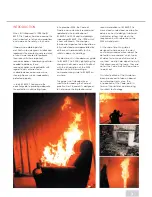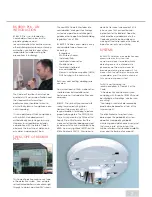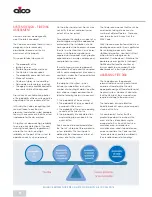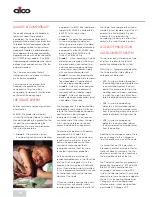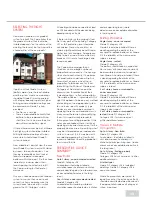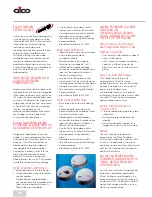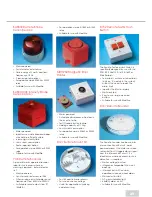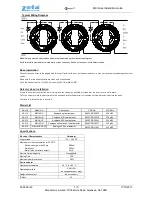
16
In the event of a fire being detected, a
small vibrating pad located beneath the
sleeper’s pillow gently alerts them. At the
same time a powerful strobe light flashes
to provide a further visual warning.
Devices such as these are now
increasingly cited as important
considerations and should be considered
as a matter of course in applications
where the residents are likely to be
elderly, as in a nursing home for example,
or in sheltered accommodation.
The 2004 Code notes that the final system
applied should take into account the
assessed needs of the person being
protected. However, it should always
conform to BS 5446: Pt.3 (Grade A and B
systems aside, where other standards
quoted may be more appropriate).
INSTALLATION OF GRADE
D AND E SYSTEMS
Once these considerations have all
been taken into account and the
system adequately planned, it can then
be installed, tested and commissioned.
Systems should be installed in
accordance with BS 7671 (IEE
Regulations 16th Edition) by a qualified
installer. All alarms should be fitted into
place securely and permanently, and
attention given to protecting all wiring
from impact or rodent damage by
recessing or trunking.
If you intend to install the alarms in a new
building, however, it is usually necessary to
wait until all other work on site has been
completed and the building has been
fully cleaned before installing any smoke
alarms. This is because excess dust and
debris from building work can
contaminate the alarms and render them
prone to false alarms. However, new ‘Easi-
fit’ style alarms are a useful exception,
with the wiring able to be completed
during ‘first fix’ and the detector head
simply slotted into place when all
cleaning work has been completed.
If, for any reason, other types of alarms
have to be installed before all work is
complete, ensure that they are
completely covered, particularly around
the edges, with the dust cover that should
be supplied with each alarm. Only when
all cleaning is finished should these dust
covers be removed.
POWER SOURCE
The normal supply for Grade D and E
systems is the public mains supply. A Grade
D system should be connected either to an
independent circuit at the dwelling’s main
distribution board (with no other electrical
equipment attached except for a
dedicated monitoring device) or a
separate, electrically protected, regularly
used local lighting circuit. A Grade E
system may only use the former option.
Hard wired interconnected smoke alarms
should be on one final circuit. However, the
2004 version of the code now accepts
that smoke and heat alarms using a radio
signal for the interconnect can be
separately wired from the nearest lighting
circuit with a permanent mains supply.
RADIO LINKED SYSTEMS
Pages 41-44 of the 2004 Code now set out
the criteria for radio-linked systems. It is
acknowledged now that Grades D-F systems
may use radio interconnection. However, it
warns about the potential drawbacks of
battery powered units being interconnected
in such a way if there is a need to replace
the batteries at regular intervals (by
implication mains powered radio-linked
alarms do not have these drawbacks).
As is typical with the Code, it stresses the
need to ensure that such a system meets
the needs of the application.
The new publication also goes out of its
way to recognise that the old Code
AUDIBILITY
Audibility is another factor to be
considered. The Code comments that
ideally, an alarm system should be
capable of producing a sound level of
75dB(A) at the bedhead, but that this
is unlikely to be achieved unless there
is a sounder/smoke alarm in the
bedroom itself. As there is no evidence
of life being lost in single family
dwellings due to the lower sound level
achieved by siting an alarm within 3
metres of the bedroom doors, in many
dwellings this would be acceptable. In
HMOs, where higher levels of ambient
noise is likely, additional
alarms/sounders may be necessary.
A practical way to check audibility is with
the alarm sounding in its intended
location, check that the occupant is able
to hear it in each bedroom with the door
closed above the sound of a radio set to
a reasonably loud conversation level. In
this case, interconnected alarms provide
an ideal solution, a remote alarm picking
up the fire and a sounder being triggered
to wake the occupier.
SPECIAL NEEDS
PROVISION
Back in 1995, the original Code
acknowledged the special needs of
people who are deaf or hearing
impaired and recommended the use of
alternative fire alarm systems to meet
their needs. More attention is paid to the
issue in the new 2004 update.
A special alarm can be incorporated
into domestic mains fire alarm systems
to protect people with impaired
hearing. It’s a simple, yet ingenious idea.


